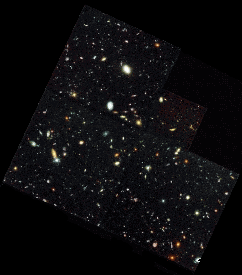


Windhorst et al. (1995) have studied another HST WFPC field and find 16 sources stronger than 7 microJy at 8GHz within an HST field; Kellermann (private communication) states that most are steep-spectrum. Thus assuming a spectral index of -0.7 we could statistically expect of order 16 sources in the field to be stronger than 24 microJy at 1.4GHz. This is 6 times the expected rms noise level of approx 4 microJy per beam. We should be able to image at least 20 sources from the HST field with the combined MERLIN+VLA dataset.
What could the faint radio sources associated with these distant galaxies be ?
Normal Galaxies Seen Face On ?
Almost certainly not since we would expect disk brightness temperatures of a few Kelvin at 1.4GHz which is well below our detection threshold.
Normal Galaxies Seen Edge On ?
Again almost certainly not since the expected brightness temperatures would be approx 30K along the galactic plane which is once again below our detection threshold. Optically however, there appear to a large number of apparently edge-on systems. Parts of these linear objects may be lensed pieces of even more distant galaxies. The radio structures of the more extended sources could indicate whether gravitational lensing has significant effects in the appearance of the distant Universe.
Core Dominated Sources ?
These would be compact (unresolved at 0.2 arcsecond resolution) and have a flat spectrum between 1.4 and 8GHz. Detection of such sources would indicate AGN activity in the faint galaxy population.
Small Classical Double Radio Sources ?
These would be elongated or double-lobed and have a steep radio spectrum between 1.4 and 8GHz. Kellermann (private communication) has shown that virtually all sources at this flux level are unresolved with a 6 arcsecond beam. With a resolution of approx 0.2 arcseconds we should be able to image such small sources successfully. The 1.4 GHz MERLIN+VLA observations will also be sensitive to any very steep spectrum compact double sources which may be missed at 8GHz by the VLA alone. These types of structure have been found to be associated with distant galaxies at higher flux levels (Fanti et al., 1995).
Starburst Galaxies ?
The best studied starburst galaxy is the nearby Irr2 galaxy M82 which lies at a distance of about 10 M light years. This is only a relatively small galaxy with a total mass of about 8x10^9} solar masses compared with around 2x10^11 solar masses for the neighbouring large Sa spiral M81 (Appleton, 1980). The steep-spectrum radio emission seen in M82 is extended only over the central 1 kpc subtending an angle of approx 1 arcminute and has a total flux density of about 10 Jy at 1.4GHz. Moving M82 to a distance of 10 B light years would produce a 10microJy source extended over 0.2 arcseconds which would just be detected in the proposed programme. If the majority of galaxies visible in the Hubble Deep Field are major disk galaxies with masses closer to M81 than M82 it is likely that starburst activity would extend further and be stronger than that seen in M82. They would be resolved and amorphous, and have steep radio spectra. These galaxies could be successfully imaged and identified.
In summary, the dual frequency approach with images at 1.4 and 8GHz matched in both sensitivity and angular resolution is vital to the interpretation of the radio data on this field. This represents an opportunity to make a significant contribution to what will clearly be one of the best studied fields in the history of astronomy.
